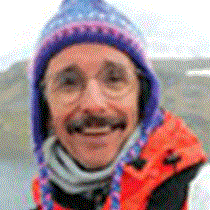At Sea, South Scotia Sea, North of Elephant Island
It’s a wildcat sea out there – 40 knots of wind and 20-foot waves – as we pitch into big sets that thunder over our bow and wash the upper decks. Foamy blue-green water cascades down the bridge windows. Torrents pour over the anchor chains and through the scuppers. The National Geographic Explorer takes it in stride, as do we, though not without staggering about and bumping into each other. Perhaps only half of us made it to breakfast this morning. The deck crew has run lines down the passageways to help us get around; the dining room staff helps us with our meals. On the sun deck, there is no sun. Only a dour gray sky made luminous by remarkable seabirds – giant petrels, pintado petrels and southern fulmars, mostly – that fly at ease in conditions that would shred most other birds. How do they do it? Again and again, we witness the miracles of nature, things too easily taken for granted, or never considered in the first place. That’s what’s nice about a trip like this. It puts new eyes in our head, new blood in our veins, new dreams in our hearts.
As on other transit days when we make the long run from one place to another, this time from the Island of South Georgia to the Antarctic Peninsula (roughly 800 miles), we are a university at sea. First, we hear a lecture on whales and whaling, then a lecture on ice. Antarctica is home to 90 percent of the world’s ice, and 75 percent of the world’s fresh water (locked up as ice). It contains ice up to 15,000ft thick, high on the polar plateau, where scientists retrieve ice cores up to 800,000 years old. It snows only two inches a year up there, but has been doing so for 20 million years, without any rivers flowing off the plateau. Hence the great volume of snow and ice accumulation. Give any geologic process enough time, what scientists call “deep time,” and the results can be astounding. Continents drift and crash into each other. Mountain ranges form and continue to rise. Species evolve. Oceans form. Epochs come and go.
Our Antarctica will be along the peninsula, the banana belt of the white continent, where more ice-free coastline exists than anywhere else, and temperatures have warmed significantly over the last 50 years. We expect the seas to lie down as we proceed south. For now, it’s high drama sailing through these ranges of roiling water, the spume flying, the birds pinwheeling, the sun beginning to dance in and out of clouds as the sky opens up, teasing us, testing us. Ahead is the bottom of the world, the seventh continent, the white wilderness that waits with infinite patience, indifferent to our desires.




